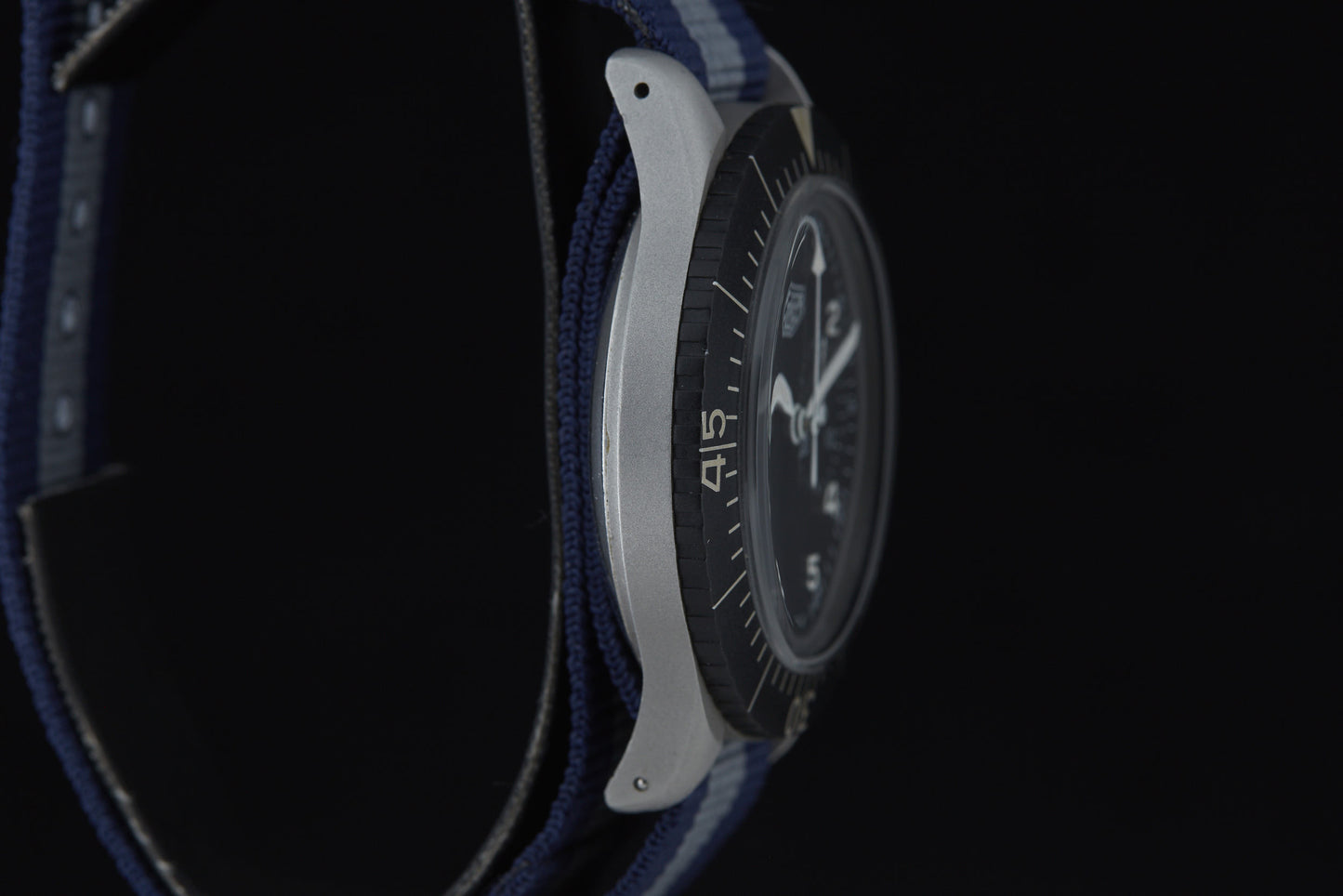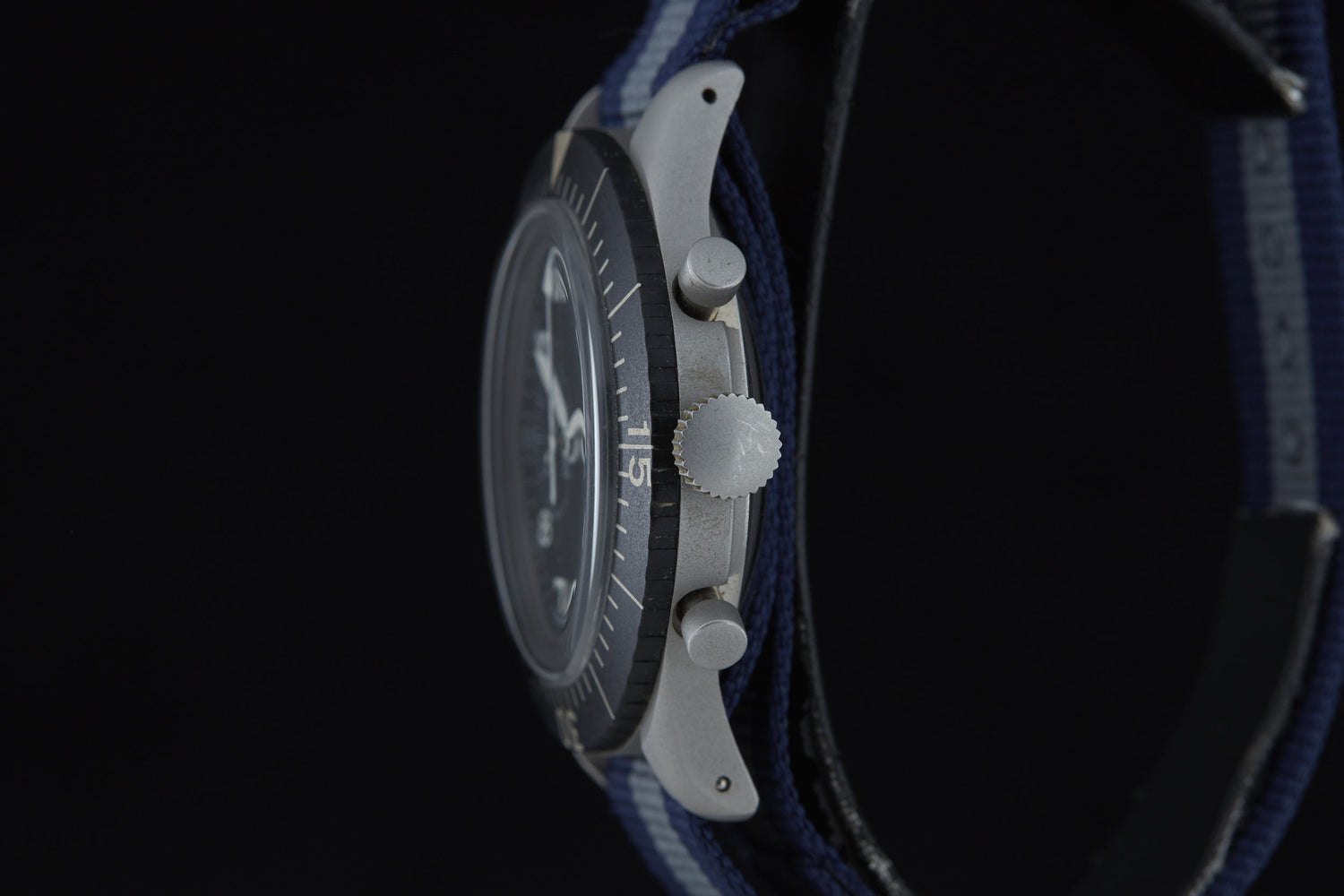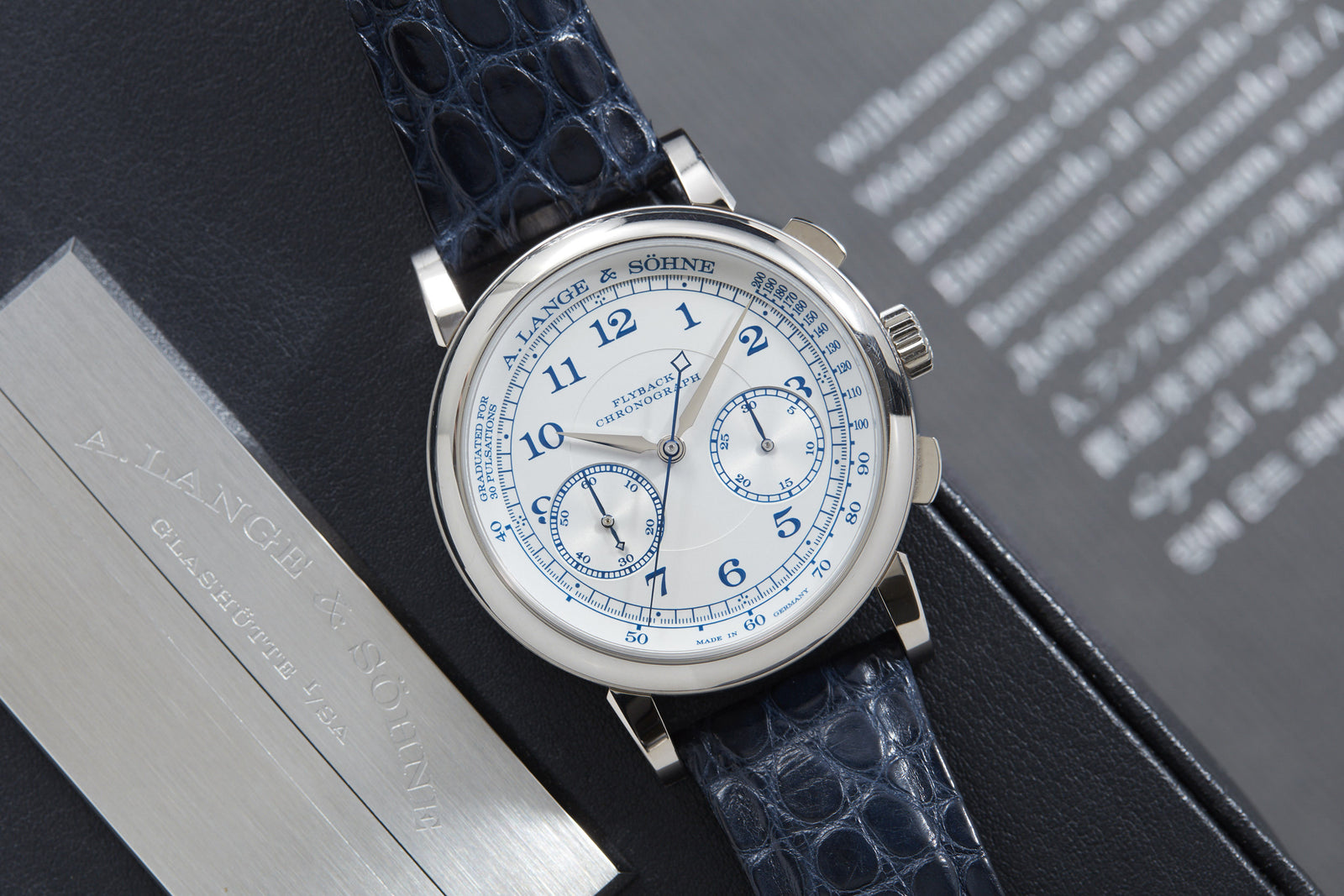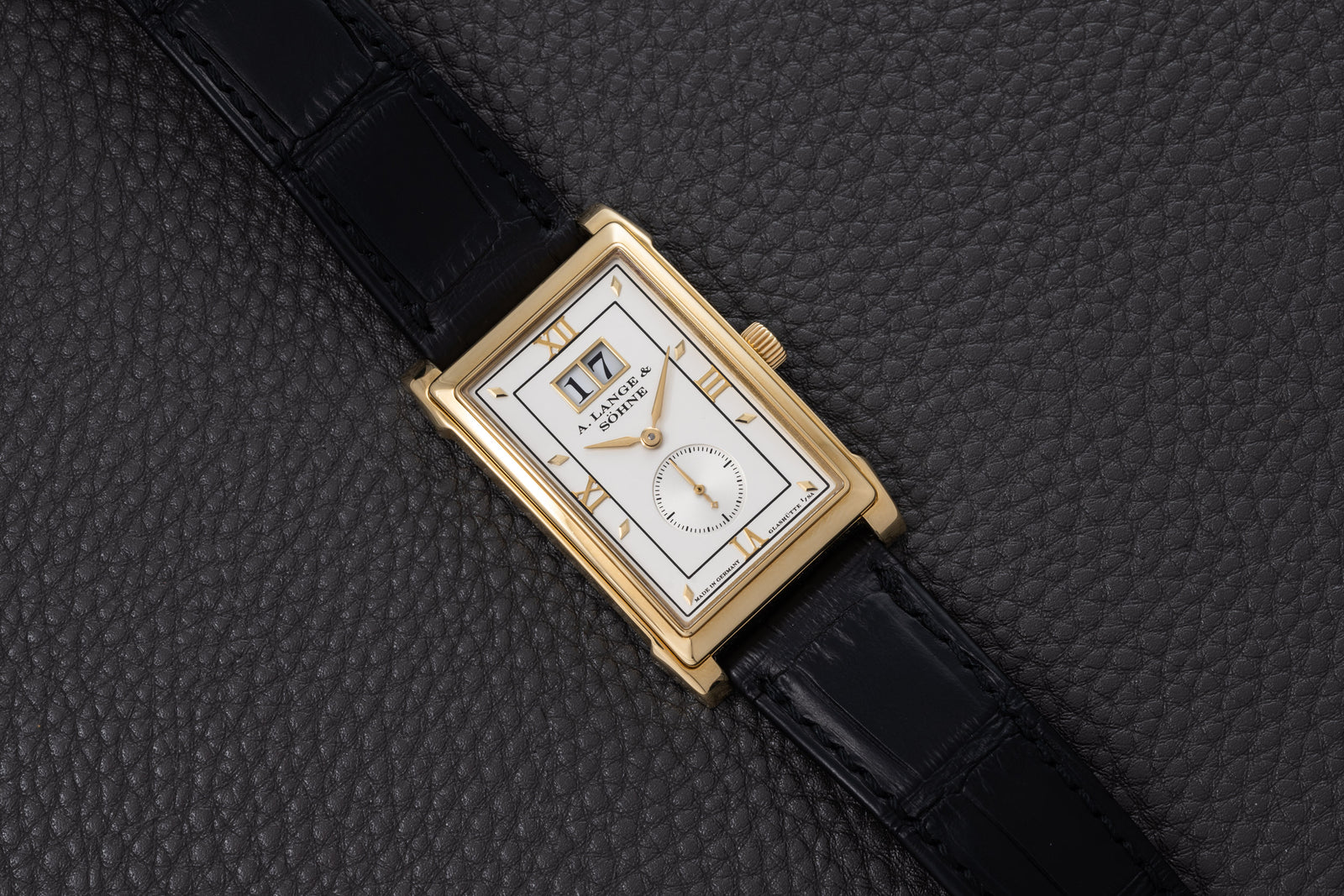Heuer Bundeswehr
- Soldspan>
- Sold
Why We Love it
–
Why We Love it
–Following the partition of Germany in 1961, tensions were uneasy between East and West. In response to the partition (which took place under cover of darkness just days after East German Chancellor Walter Ulbricht declared, “Nobody has any intention of building a wall”), NATO military leaders launched “Exercise Checkmate.” In this show of military might, the air forces of Belgium, Denmark, France, the Netherlands, and West Germany participated in a mass training exercise.
During this exercise, fighter pilots from the West German 32nd Flight Bomber Wing unknowingly strayed into East German airspace due to an equipments malfunction and were pursued by a squadron of Soviet fighters. As soon as the West German pilots safely landed back in West Berlin, the West German Defense Minister issued an apology to Soviet representatives in Bonn, the capital of West Germany. In response to this incident (which goes down in history as the F-84 Thunderstreak incident), the Soviets referred to it as “provocation” and threatened to shoot down any aircraft that strayed into East German airspace.
It wouldn’t have been the first time the Soviets shot down Western airplanes. On May Day of 1960 (the year before the Berlin Wall was erected), a Lockheed U-2 spy plane piloted by American Francis Gary Powers took off from the U.S. air base in Peshawar, Pakistan and sparked an international incident. The purpose of the mission—with the code word GRAND SLAM—was, according to Powers, to “fly all the way across the Soviet Union… deeper into Russia than we had ever gone, while traversing important targets never before photographed.”
The U-2—with its ability to fly at high altitudes, above 60,000 feet—was thought to be unreachable by Soviet fighter planes and surface-to-air-missiles. However, when Powers took off from Peshawar on that May morning, Soviet Air Defense Forces in Central Asia were already on high alert, with orders to “attack the violator by all alert flights located in the area of [the] foreign plane’s course, and to ram if necessary.” Powers managed to evade several Soviet MiG-19 fighter jets that had been deployed to intercept him, but was finally brought down by a barrage of S-75 Dvina surface-to-air-missiles.
Due to Powers’s inability to activate the plane’s self-destruct mechanism (and his unwillingness to use the suicide device the CIA had provided him), the Soviets learned of his mission. He was taken immediately to Lubyanka Prison in Moscow and, after being interrogated by the KGB, he was forced to issue a public apology. Powers was tried for espionage before the Supreme Court of the USSR, found guilty, and imprisoned for nearly two years. His exchange for Soviet KGB Colonel Vilyam Fisher at the Glienicke Bridge in Berlin on February 10, 1962, was depicted in the recent film Bridge of Spies. Though Powers was found by American authorities to have “lived up to the terms of his… mission and in his obligations as an American,” feelings were frosty between the Soviets and the Western powers, which was only compounded by the Thunderstreak Incident in 1961.
Three years later, on January 28, 1964, the Soviets once more made good on their word to shoot down any planes—armed or otherwise—that strayed too far into Soviet airspace.
That day, an unarmed training aircraft—a USAF T-39A-1-NO Sabreliner—took off from Wiesbaden, West Germany on a routine training exercise. On the flight were two student pilots, Lt. Col. Gerald K. Hanford and Captain Donald G. Millard, who were being trained by their instructor, Captain John F. Lorraine, to qualify for the T-39. 47 minutes after takeoff, U.S. air defense stations in West Germany detected the Sabreliner shooting toward East Germany at 500 miles per hour. Despite frantic warnings from the dispatchers at the defense stations, the T-39 continued on its course.
Five minutes after the T-39 crossed into East German airspace, U.S. radar showed that two planes—undeniably Soviet—intercepted the unarmed American jet. After a tense six minutes, the Soviet planes—just blips on the radar—veered west while the US airplane disappeared. Two hours later the US Military Liaison Mission in Berlin were alerted to be on standby for a search and rescue mission of American airline, arriving to the crash site to find that the crew was dead.
This watch, a Heuer Bundeswehr, was General Issue for the pilots of the West German Luftwaffe during the period that the T-39 Incident took place. From the 1960s to the 1970s, the "Bund" (as it's affectionately known) saw a range of dial configurations that baffle those not in the know. Fortunately, the Heuer experts over at On The Dash have complied a comprehensive overview of these variations.
This particular example features a "clean" or "civilian" dial with no military markings, but does have a military stamped case back--not at all unusual given their long production run and batch production. Furthermore, the presence of military markings on the case back leads us to believe that it might have been refurbished by Sinn, who took over the contract with the Bundeswehr from Heuer in the 1980s. This type of dial is also known as a "T-Only" dial among collectors due to the small marking indicating the use of tritium lume just above 6 o'clock. Interestingly, this particular example also features hour markers not "cut off" at 2,4,8 and 10, only one of a handful known to the Bundeswehr collecting community.
Furthermore, this particular example is in excellent condition, featuring a sharp case without the common over polishing, original pushers, crown, and bi-directional rotating bezel. For our part, we have a fondness for military chronographs, and this is without a doubt one of our favorites. The Bund--with its sharp looks, stalwart movement, and genuine military history--is hard to surpass.
A:S Guarantee
+
A:S Guarantee
+Our Pledge
Analog:Shift stands behind the authenticity of our products in perpetuity.
Condition
Since our pieces are vintage or pre-owned, please expect wear & patina from usage and age. Please read each item description and examine all product images.
Warranty
We back each Analog:Shift vintage timepiece with a two-year mechanical warranty from the date of purchase.
International Buyers
Please contact us prior to purchase for additional details on shipping and payment options.
Shipping & Returns
+
Shipping & Returns
+All of our watches include complementary insured shipping within the 50 states.
Most of our products are on hand and will ship directly from our headquarters in New York City. In some cases, watches will be shipped directly from one of our authorized partners.
We generally ship our products via FedEx, fully insured, within 5 business days of purchase. An adult signature is required for receipt of all packages for insurance purposes. Expedited shipping is available at an additional cost. We are also happy to hand deliver your purchase in Manhattan or you may pick it up at our showroom.
Returns must be sent overnight or by priority international delivery, fully insured and paid for by the customer. A restocking fee may apply. Watches must be returned in the same condition as initially shipped.
We welcome international buyers, please contact us prior to purchase for additional details on shipping and payment options.








Heuer Bundeswehr
- Soldspan>
- Sold







































